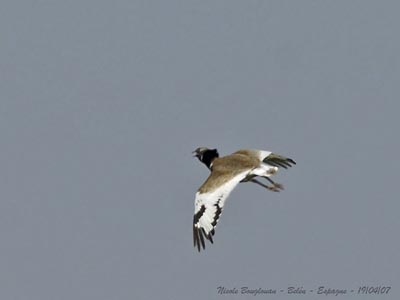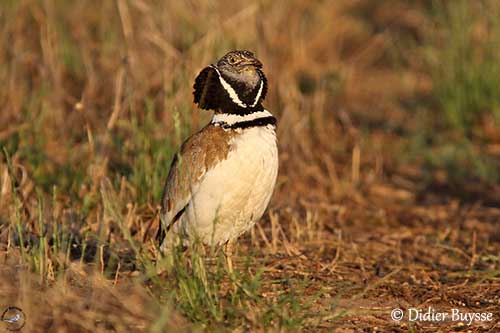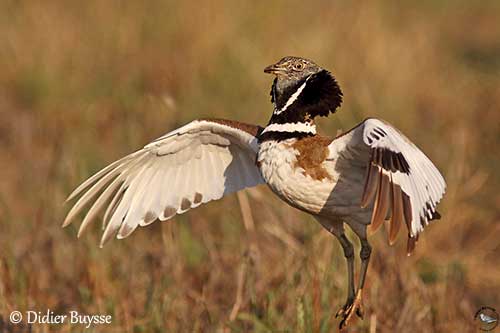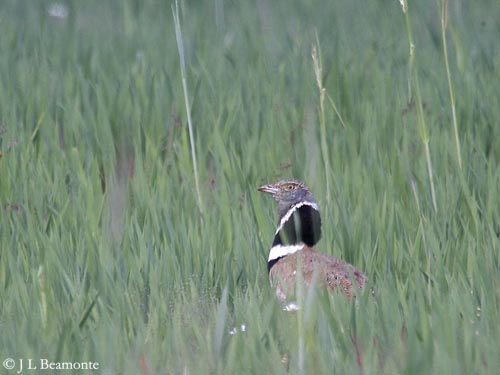
Little Bustard
Tetrax tetrax
Otidiformes Order – Otididae Family
BIOMETRICS:
Length: 43 cm
Wingspan: 110 cm
Weight: M : 795-975 g – F : 680-945 g
DESCRIPTION:
Smaller than the Great Bustard, the Little Bustard is often seen in the same areas and habitats.
It is a stocky bird, showing distinctive neck pattern in breeding plumage.
Farm-reared birds are released and introduced in suitable habitat. Preservation of the habitat and low-intensity farming are necessary, as the reduction of the hunting pressure.
Fr: Outarde canepetière
All : Zwergtrappe
Esp : Sisón Común
Ital : Gallina prataiola
Nd : Kleine Trap
Russe : Стрепет
Sd : Småtrapp
Port : Sisão
Photographers :
José Luís Beamonte
Pájaros de España
Didier Buysse
Vision d’Oiseaux
Nicole Bouglouan
PHOTOGRAPHIC RAMBLE
Text by Nicole Bouglouan
Sources :
HANDBOOK OF THE BIRDS OF THE WORLD Volume 3 by Josep del Hoyo-Andrew Elliott-Jordi Sargatal - Lynx Edicions - ISBN : 8487334202
THE HANDBOOK OF BIRD IDENTIFICATION FOR EUROPE AND THE WESTERN PALEARCTIC by Mark Beaman, Steve Madge - C.Helm - ISBN: 0713639601
L’ENCYCLOPEDIE MONDIALE DES OISEAUX - Dr Christopher M. Perrins - BORDAS - ISBN: 2040185607
BirdLife International (BirdLife International)
Pájaros de España (JL Beamonte)
Wikipedia (Wikipedia, The Free Encyclopedia)

Adult male in breeding plumage has buffy brown upperparts, finely vermiculated with black.
On the wings, the flight feathers and the greater coverts are pure white. The hand is black, and primaries are tipped black. When in flight, we can see a black crescent at the bend of the wing.
The tail is white with brown mottling and three bars. Tip is white.
Underparts are white too.
On the head, crown is streaked brown. The face is blue-grey, extending into a point to chin and throat. A broad white V borders this point and joins the nape. Neck and breast are black with broad black band across the breast, as semi-collar.
The black neck feathers form a ruff when the bird is excited.
The strong bill is grey. Eyes are pale yellow. Legs and feet are pale yellowish-grey.

The non-breeding male lacks the black and white neck pattern, and shows rufous feathers spotted blackish-brown.
Female is similar to non-breeding male, with more marked upperparts.
Juvenile resembles adult female, with more buff and dark barring on wing coverts.
VOICE: SOUNDS BY XENO-CANTO
The Little Bustards, male and female, are usually silent, but during the courtship displays, the male stamps noisily while it gives nasal “prrt”.
We can also hear high-pitched whistling sound produced by the primary flight feathers when the male performs the wing-flapping displays.
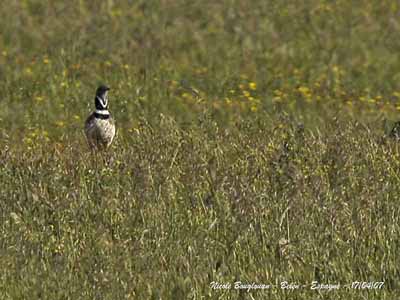
HABITAT:
The Little Bustard frequents steppes, open flat and rolling short-grass plains, pastures and some cultivated areas such as legume crops.
This species needs vegetal cover for nesting, and undisturbed places.
RANGE:
The Little Bustard breeds in southern Europe and North Africa, to W and C Asia.
The northernmost populations migrate southwards in winter, whereas the southern birds are mainly resident or dispersive.

BEHAVIOUR:
The Little Bustard feeds on large insects and terrestrial invertebrates, but it also takes plant material such as shoots, leaves, flowerheads and seeds.
This bird walks slowly, and prefers to run if disturbed, rather than fly.
Outside the breeding season, they are gregarious and form large feeding flocks in the fields.
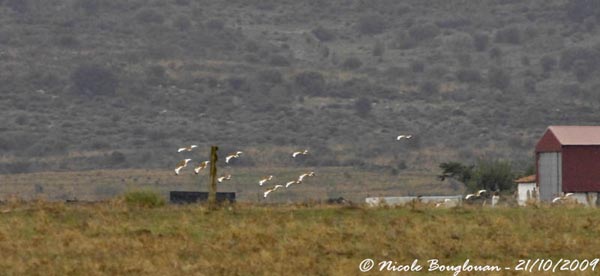
The male performs spectacular displays to attract females. The “jumping display” takes place on a mount of bare earth, or on small patch of clear ground.
The bird starts with brief foot-stamping, producing some noise. Then, it leaps about 1, 50 metre into the air while uttering its nasal “prrt”. At the same time, it performs wing-flapping, producing the characteristic “sisisisi” sound. This display usually occurs at dawn and dusk, and lasts a few seconds, but the nasal call may be heard throughout the daylight hours.
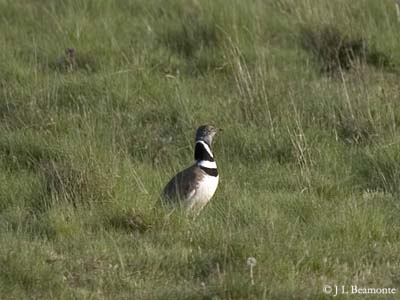
During the displays, the male erects the black ruff in order to expose the black and white neck pattern, and throws back the head to call. The jumping-displays allow the male to expose the pure white wings.
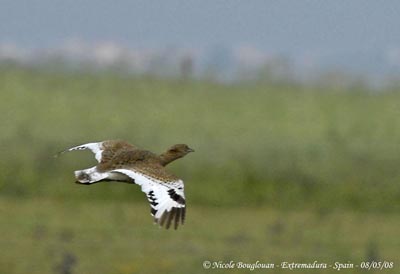
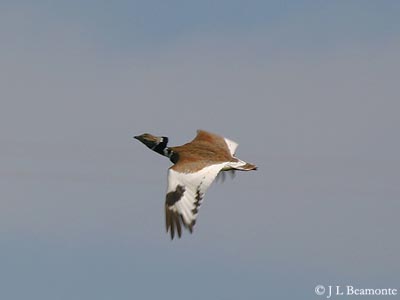
FLIGHT:
The Little Bustard flies with outstretched neck, with rapid shallow wing-beats of slightly curved wings.

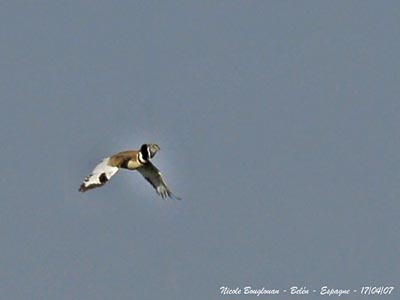
REPRODUCTION:
Breeding season occurs between February and June.
The nest is a shallow depression on the ground, concealed in dense grassy cover.
Female lays 2-6 eggs, and incubates alone during about three weeks. The male remains close to the nest-site. If a predator approaches, both adults circle above the head of the intruder.
The precocial chicks are covered in buff down with dark streaks and mottling. They fledge about 25-30 days after hatching. They remain with their mother into the autumn.
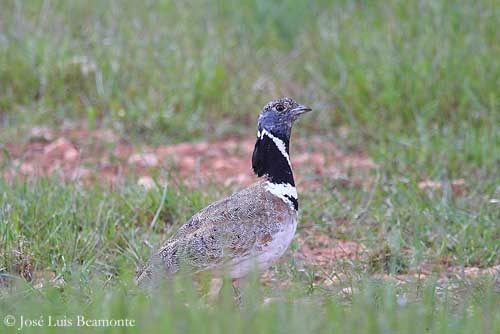
DIET:
The Little Bustard feeds on large insects such as beetles and grasshoppers, and others similar. It also takes terrestrial invertebrates and consumes plant material such as shoots, leaves, flowerheads and seeds.
This species feeds also on earthworms, molluscs and amphibians.
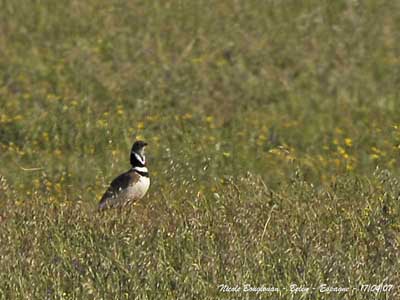
PROTECTION / THREATS / STATUS:
The Little Bustard is currently considered Near-threatened.
Populations suffered declines due to habitat loss and changes in the agricultural practices. The use of pesticides involves lack of food.
Collisions with overhead powerlines and illegal hunting are important local threats.
